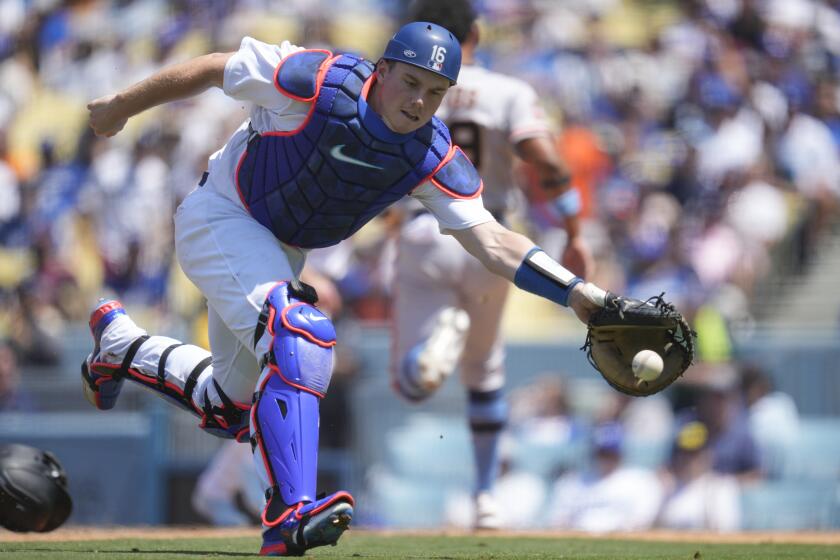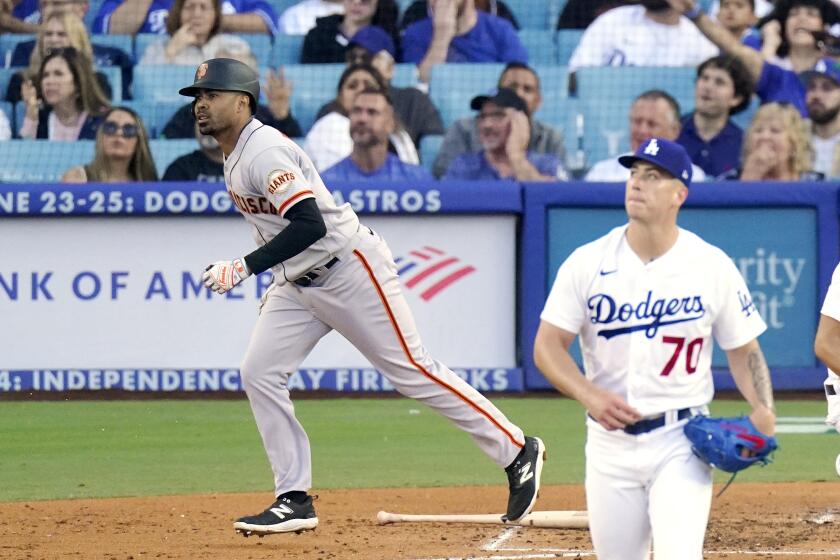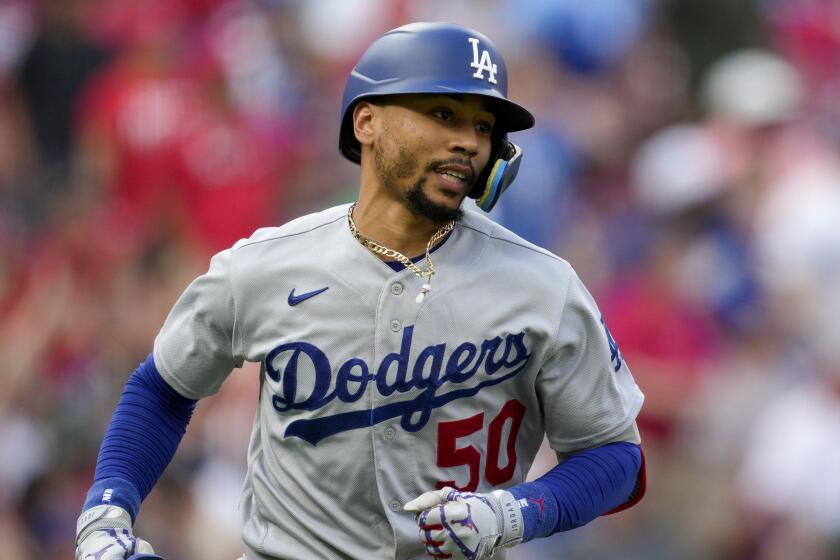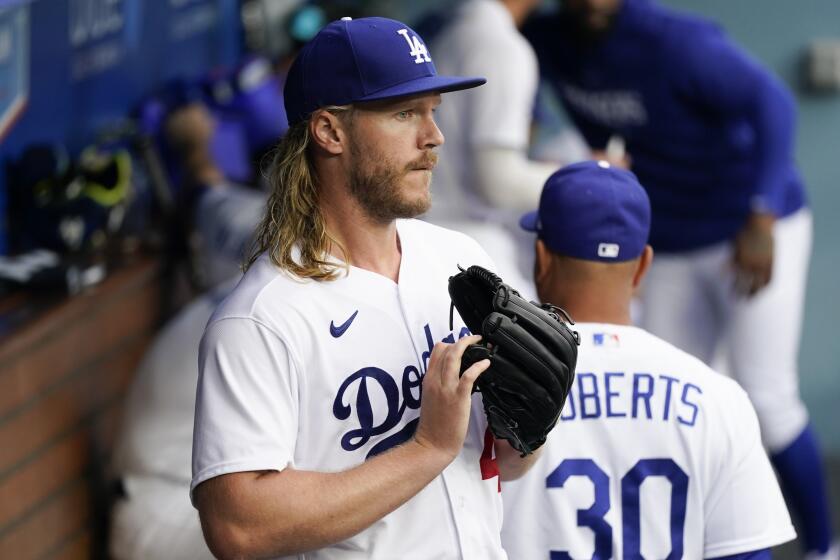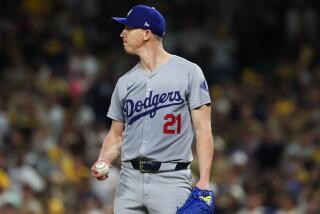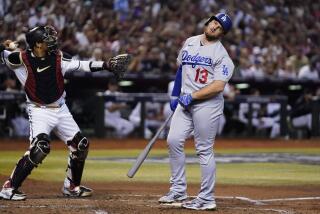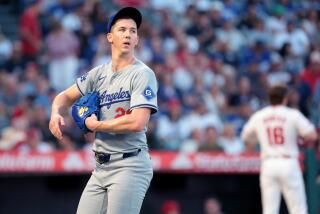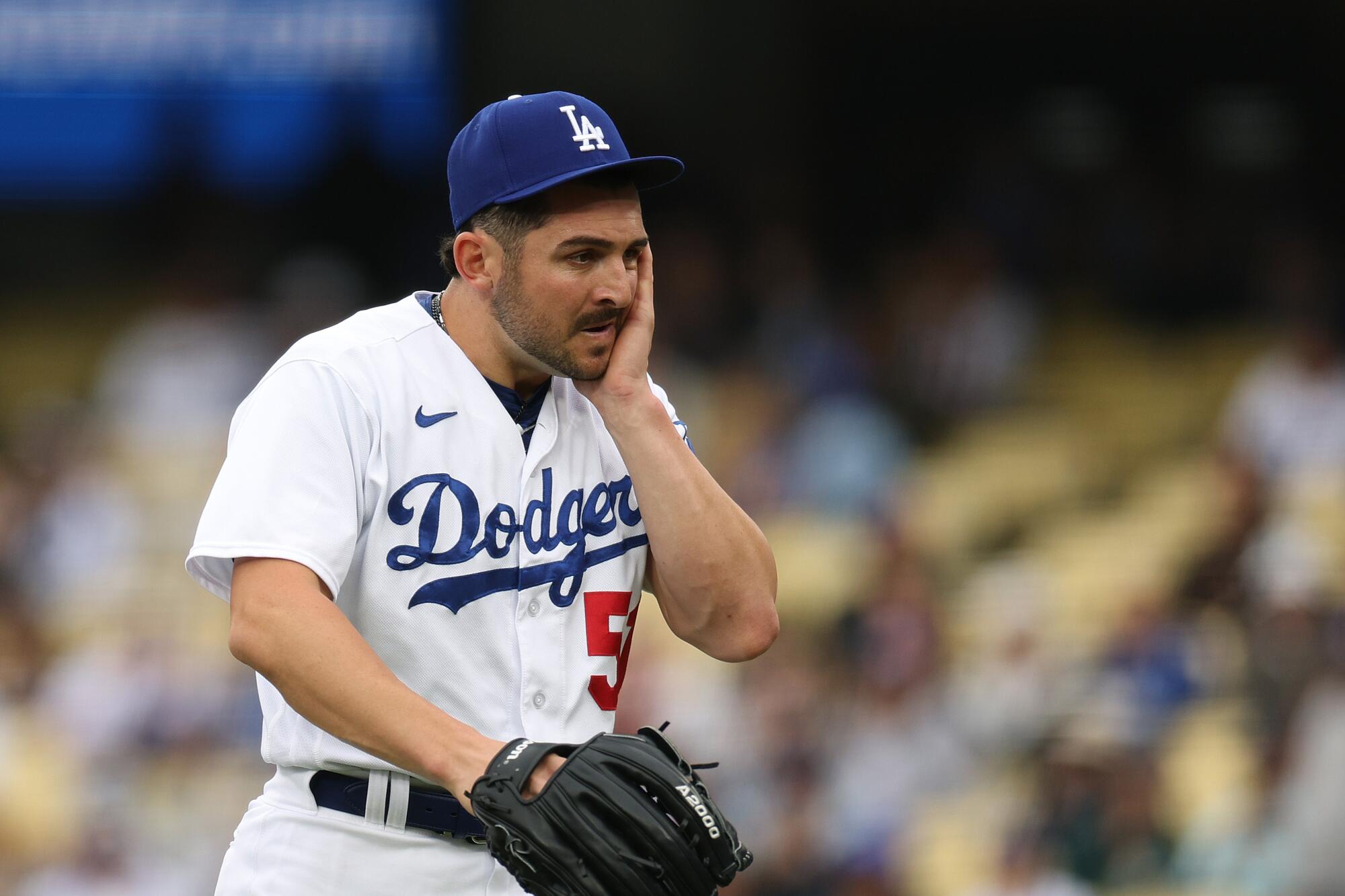
In their 66 years of playing baseball in Los Angeles, the Dodgers have never fielded a pitching staff with numbers this bad.
Not in their early Southern California years, when their makeshift home at the Coliseum measured just 250 feet to straightaway left.
Not in the doldrums of the 1990s and early 2000s, when the team failed to win a playoff game over a 15-year stretch.
Even Frank McCourt’s cash-strapped squads were able to maintain the franchise’s long-established legacy of pitching excellence, always remaining at least competitive on the mound.
The Giants finish a three-game sweep of the Dodgers, who have lost 18 of their last 30. Tony Gonsolin gives up a career-high seven runs in a 7-3 loss.
This season, however, the club has found itself in uncharted territory. After leading the majors in earned-run average each of the last four seasons, they’re stunningly 25th out of 30 teams in MLB this season, owning a 4.66 mark that would be the highest in franchise history since 1944.
As a result, the Dodgers are struggling in ways they rarely have during the Guggenheim Baseball-Andrew Friedman-Dave Roberts era. They’ve lost 18 of their last 30 games. They are in third place in the NL West after being swept by the San Francisco Giants this weekend.
“In a lot of ways, we have built a lot of our successful teams on elite pitching,” said Friedman, the Dodgers president of baseball operations. “And we’ve fallen short of that to this point.”
So far, their search for answers has met nothing but dead ends, the club spinning its wheels with a shorthanded rotation, an overmatched bullpen and a revolving door of young pitchers struggling to fill the gaps.
“There’s a lot of different layers to why, collectively, we haven’t performed,” pitching coach Mark Prior said. “Some of that is certain individuals’ ability to execute pitches at different times has not been great. Some of it has been the lack of depth from our starting rotation, as far as getting deeper into games.”
The one thing everyone can agree on: “We have not pitched well,” Prior said. “There’s really no sugar-coating it.”
And until it turns, the Dodgers’ ability to be a true contender, and make a legitimate push for a World Series, will remain in question.
Here are four observations on what has gone wrong, and how the Dodgers are trying to fix it.
The bullpen isn’t executing
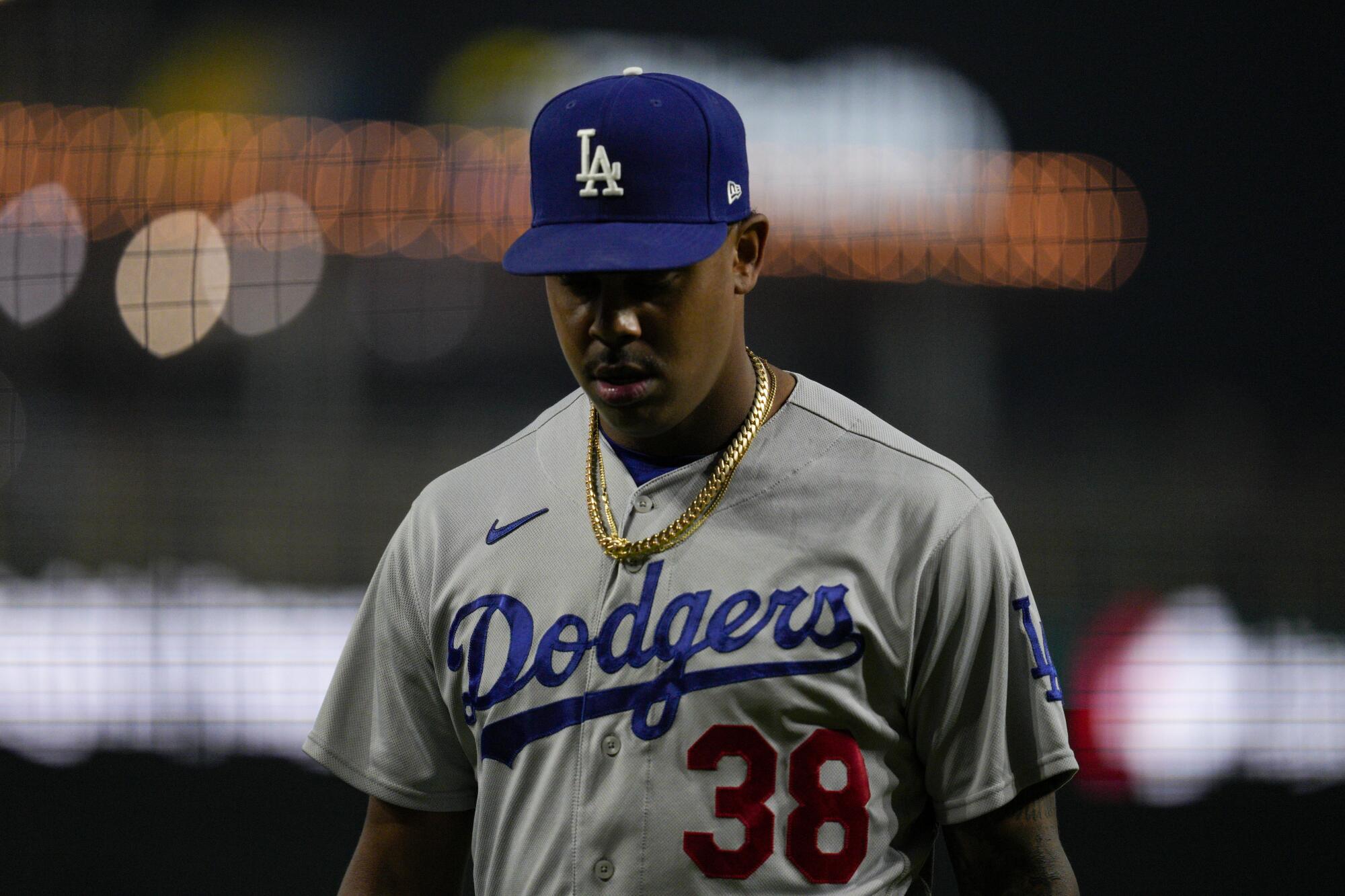
“It’s pretty clear the whole group is pretty frustrated with the results we’ve been getting.”
— Evan Phillips, Dodgers reliever
Any way you slice it, the Dodgers bullpen numbers have been ugly this season.
Their 5.04 ERA ranks 29th in the majors. Their 1.38 walks and hits per inning and .260 opponent batting average are both bottom six. They’ve blown only eight save opportunities, but have still combined for 14 losses, tied for ninth most in MLB.
And the underlying metrics haven’t been much better — with the team regressing from last season in strikeout rate, walk rate, home run rate and hard hit percentage.
Even with many of the same pieces as last year’s relief corps (which led the National League in bullpen ERA), the club’s bullpen is getting hammered in ways the franchise has rarely recently seen.
“It’s pretty clear the whole group is pretty frustrated with the results we’ve been getting,” right-hander Evan Phillips said. “But better now than later in the year. I think it’s good for us to struggle and learn from these things right now, and hopefully correct it quickly.”
Phillips has been the most consistent member of the unit, posting a 2.28 ERA and seven saves in his part-time closer, part-time fireman role.
After four stellar outings to open his MLB career, Dodgers pitcher Bobby Miller struggles and the bullpen falls apart in a 15-0 loss to the Giants.
Beyond him, however, almost every other reliever has struggled for various reasons.
Brusdar Graterol is hardly inducing any swings and misses, entering Sunday ranked 366th out of 383 qualified pitchers with a 16.5% whiff percentage.
While he has still managed a 2.40 ERA, his inability to limit contact has put pressure on the defense and led to several costly unearned runs, a couple of which resulted from errors he committed himself.
Yency Almonte (6.30 ERA) and Alex Vesia (8.00 ERA) have both backslid after ascending into key roles last year, with inconsistencies in their execution of breaking pitches allowing opponents to sit on their heaters.
Caleb Ferguson (3.46 ERA) and Victor González (3.66 ERA) have offered more consistent production from the left side. But they’ve both faltered in several late-game, high-pressure situations.
And other than Shelby Miller (2.40 ERA), the team hasn’t found any other uncovered gems, unsuccessfully cycling through a cast of unproductive arms like Phil Bickford, Justin Bruihl, Wander Suero and more.
“Our guys are, for the most part, the same, with really good stuff in place,” Friedman said. “So we’ve just got to figure out with each guy, how to organize it better from pitch selection to execution.”
A banged-up rotation is providing little cover
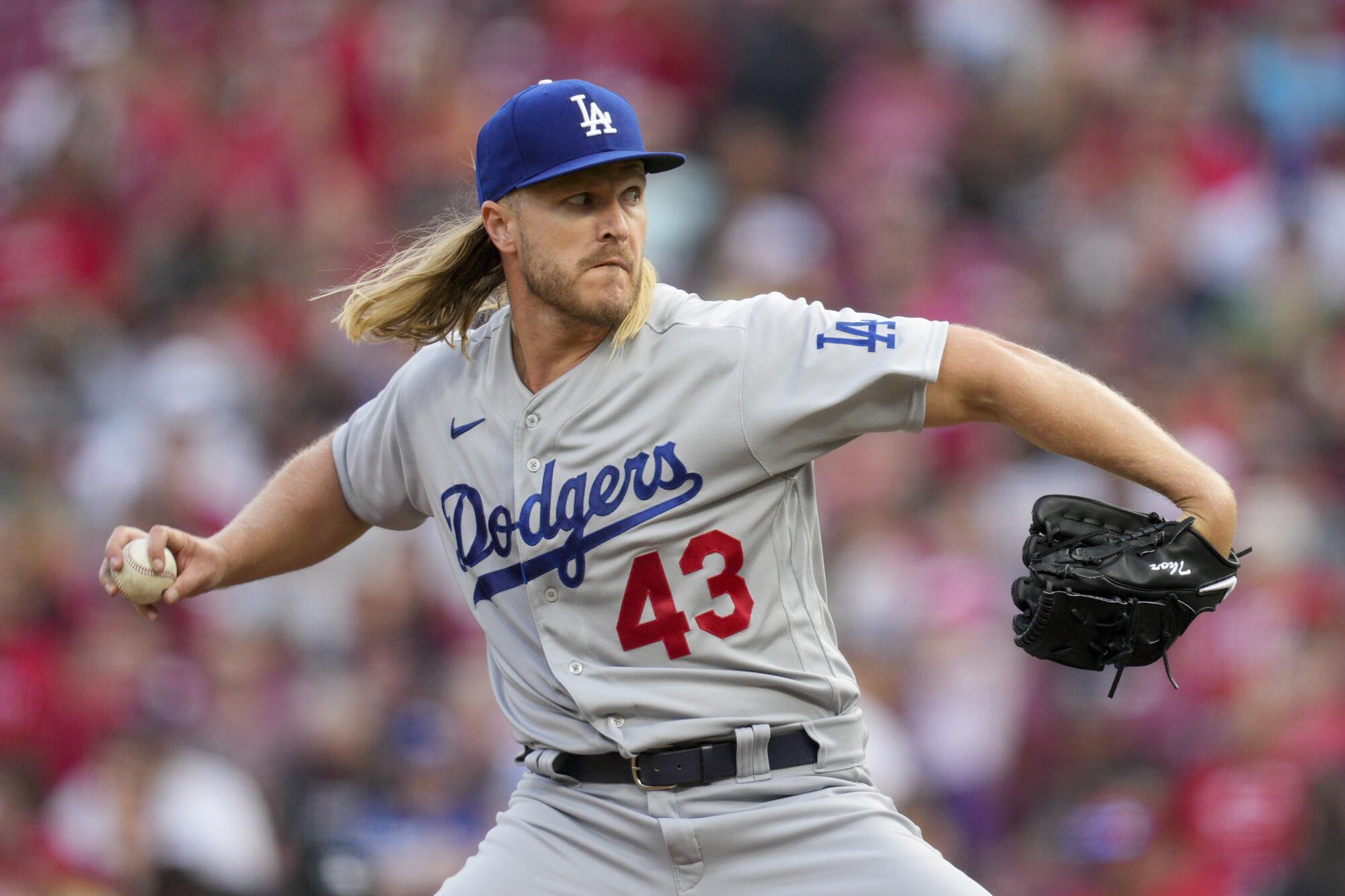
In past years, the Dodgers’ starting rotation might have been able to cover for some of their bullpen deficiencies.
This season, that group has been struggling to stay afloat itself, ranking 16th with a 4.38 ERA and averaging barely five innings per start (20th in the majors).
In what has become a common theme for the club in recent years, injuries have taken a toll.
Tony Gonsolin (4-2, 2.92 ERA) missed the opening month with an ankle sprain and hasn’t been in top form since, giving up a career-high seven runs Sunday.
Julio Urías (5-4, 4.39 ERA) has missed the last month with a hamstring strain, following an up-and-down start to his campaign.
Dustin May, meanwhile, is on the 60-day injured list with a forearm strain, leaving the oft-injured Clayton Kershaw (8-4, 2.95 ERA) as the only starter yet to miss time this year.
“Things are going to happen, as far as health. That’s part of it. But there’s things that we have to do better when things aren’t going well.”
— Dave Roberts, Dodgers manager, on injuries to pitchers
An equally consequential problem, though, has been the Dodgers’ lack of depth behind them.
Last season, Tyler Anderson and Andrew Heaney gave the team a crucial veteran presence when Walker Buehler went down. Mitch White ate important innings in a swingman role as well.
This season, the club’s rotation options have already worn thin.
Their lone offseason addition, Noah Syndergaard, flamed out in disastrous fashion, a $13-million mistake whose future is unclear (technically, Syndergaard has been sidelined in recent weeks by a blister, but his 7.16 ERA was the much bigger issue).
Beyond him, the team has relied upon a young collection of starters who have largely been hurt, inconsistent or seemingly in over their heads.
Ryan Pepiot was supposed to open the season in the rotation, but sustained an oblique strain that continues to plague him three months later.
Gavin Stone was hyped up internally as perhaps the Dodgers’ most MLB-ready prospect, only to get knocked around in three big league starts and sent back to triple A for a reset.
Speaking to Harold Reynolds on MLB Network, Dodgers right fielder Mookie Betts says he’ll take part in the MLB Home Run Derby if he’s selected as an All-Star.
Michael Grove was supposed to be this year’s version of White — a solid but unspectacular prospect capable of the occasional spot starts or bulk innings out of the bullpen. But even with improved velocity, he has struggled to perform, posting an 8.10 ERA in 30 innings.
Bobby Miller and Emmet Sheehan have been the lone exceptions, flashing potential in their debut MLB stints. A group of other highly touted prospects still beckon behind them in the farm system.
Still, none of those young arms have yet to fully establish themselves at the big league level.
And while Prior acknowledged it all has “put added pressure” on the team’s scuffling bullpen, Roberts has begun to highlight another detrimental side effect.
“It’s been hard, obviously, to build any kind of momentum,” the manager said, his team having failed to win consecutive games in June. “Things are going to happen, as far as health. That’s part of it. But there’s things that we have to do better when things aren’t going well.”
Two-strike woes and road struggles
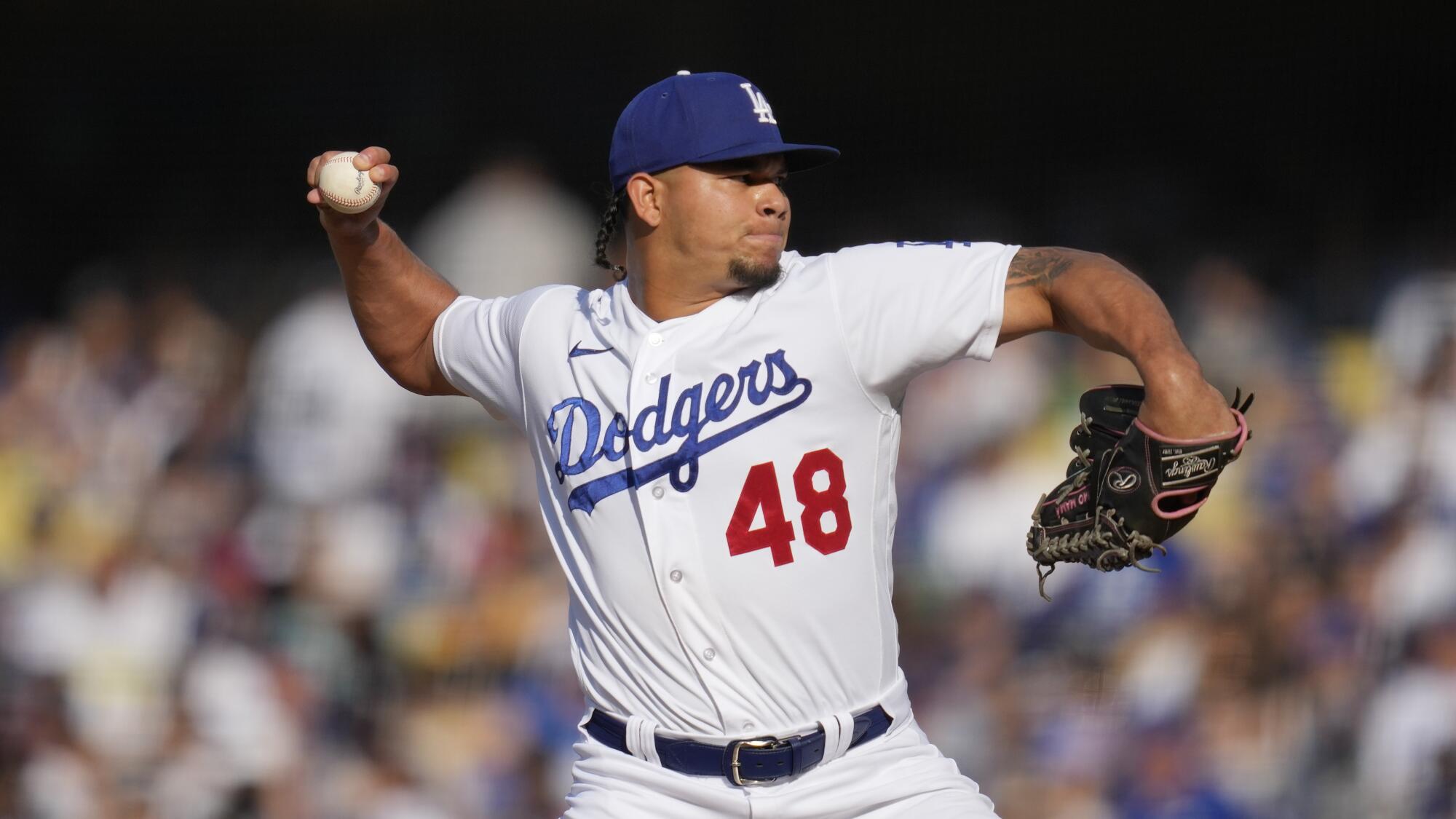
Of the many statistical splits that have underlined the Dodgers’ pitching struggles, two stand out more than most.
The first is the difference between the team’s ERA at home (3.70, 10th best in the majors) and the road ERA (a woeful 5.70, ahead of only the tanking Oakland Athletics). It’s an eye-catching difference, but one the team has written off as an anomaly.
Prior noted those numbers have been skewed by the fact most of the team’s worst pitching performances (Saturday’s 15-0 loss at home to the Giants, aside) have been on their travels.
Phillips called the splits a “coincidence,” deadpanning that “we don’t go on the road and talk about, ‘Oh geez, I guess we’re not gonna do good.’ ”
Noah Syndergaard said he would give his “hypothetical first born” to be his old self again, but the Dodgers can’t count on that happening.
The other outlier stat is much more telling: In two-strike counts, the Dodgers haven’t been nearly as good at putting batters away.
Last season, opponents hit just .140 against the Dodgers once they got to two strikes, an MLB-low. They struck out more than 45% of the time, the fourth-highest rate in the majors.
This year, the staff hasn’t been nearly as clinical.
Opponents are batting .175 in such situations and striking out only 42% of the time — both below-league-average rates that have led to extended innings and soul-crushing rallies.
“We just gotta get better,” Prior said. “We gotta be smarter with how we’re using our pitches, and being able to, when we get to two strikes, put these guys away.”
So what’s the fix?
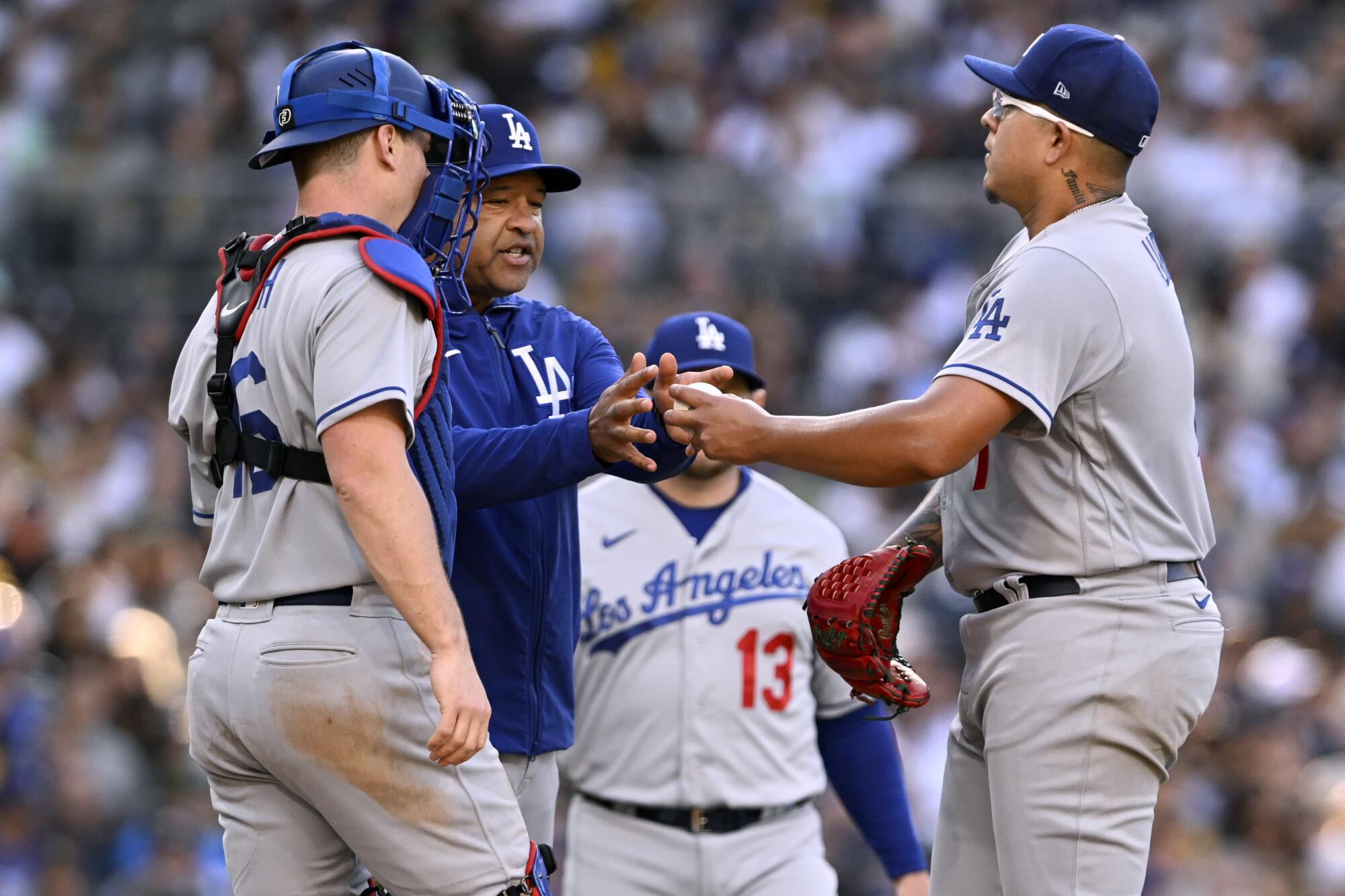
In the short-term, the Dodgers are banking on an internal turnaround.
There are some indications they’ve been the victim of bad luck.
For example, their 4.34 mark in “fielding independent pitching” (an advanced analytic similar to ERA that tries to isolate pitching performance from variables such as defense) is lower than their actual earned-run average, something that has rarely been the case in recent seasons.
Their defense, a trademark strength for the club prior to MLB’s elimination of the infield shift this season, has also faltered. According to Sports Info Solutions, the team is a minus-five in defensive runs saved, ranking 19th in the majors (granted, poor fundamentals from the pitchers themselves has been a leading factor).
Better health will help, too, especially with Urías and veteran reliever Daniel Hudson expected back by the start of July.
And there’s always the trade deadline, where top starters like Marcus Stroman of the Chicago Cubs or Lucas Giolito of the Chicago White Sox could be available, as well as a likely wide selection of relief pitchers.
But in a market that will be full of buyers, and potentially short on all-out sellers, completing a total pitching staff makeover could be hard to complete.
The Dodgers honoring the Sisters of Perpetual Indulgence activist organization inside Dodger Stadium on Friday countered the protests outside.
That’s why, for now, the Dodgers’ biggest hope is that some of their struggling arms can make quick strides; for many of their own pitchers — from a crop of inconsistent relievers to their underwhelming veteran starters to the barrage of prospects getting their first MLB opportunities — to simply pitch better.
“We still have faith in a lot of these guys, their ability to get outs,” Prior said.
Added Friedman: “I’m confident that as we go guy by guy, that there’s very compelling upside stories, that when we look back a month from now it will be very different.”
Friedman, however, also noted a caveat.
“Obviously,” he said, “we have to do it.”
And with the season nearing its halfway point, the clock is indeed ticking, with the Dodgers uncharacteristic pitching woes threatening to become a historic disappointment.
More to Read
Are you a true-blue fan?
Get our Dodgers Dugout newsletter for insights, news and much more.
You may occasionally receive promotional content from the Los Angeles Times.

